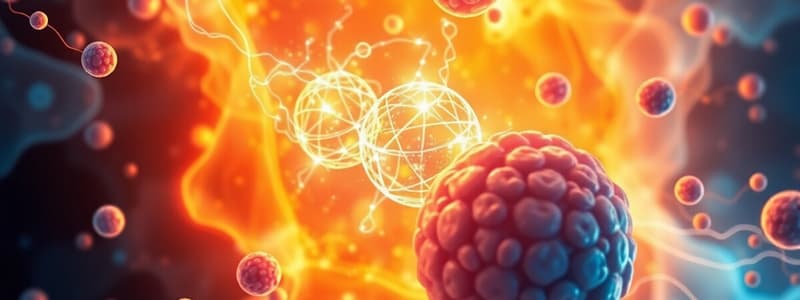Podcast
Questions and Answers
What is the primary focus of pharmacodynamics?
What is the primary focus of pharmacodynamics?
- The structural formula of various drugs
- The metabolism of medications in the liver
- The actions of drugs on the body (correct)
- The therapeutic index of a drug
What does the mechanism of action describe in terms of medication?
What does the mechanism of action describe in terms of medication?
- The side effects associated with the medication
- How a medication alters the drug's chemical composition
- The physiological function of receptor sites
- How a medication works in the body (correct)
How does increasing the dose of a medication typically affect its response?
How does increasing the dose of a medication typically affect its response?
- It guarantees a safer therapeutic index
- It only increases the response without any toxicity risk
- It has no effect on the response
- It may increase the response and risk of toxicity (correct)
What is a receptor in the context of pharmacodynamics?
What is a receptor in the context of pharmacodynamics?
What describes a ligand in pharmacodynamics?
What describes a ligand in pharmacodynamics?
What does potency of a drug refer to?
What does potency of a drug refer to?
Which of the following drugs is considered to have a low therapeutic index?
Which of the following drugs is considered to have a low therapeutic index?
What does a higher therapeutic index indicate about a drug?
What does a higher therapeutic index indicate about a drug?
What is represented by the term TD50 in pharmacology?
What is represented by the term TD50 in pharmacology?
Which class of drugs generally has a higher therapeutic index?
Which class of drugs generally has a higher therapeutic index?
What term describes the amount of drug needed to produce an effect?
What term describes the amount of drug needed to produce an effect?
Which type of receptor is activated by a chemical that has both affinity and intrinsic activity?
Which type of receptor is activated by a chemical that has both affinity and intrinsic activity?
Which receptor type is primarily involved in gene regulation by recognizing small, hydrophobic ligands?
Which receptor type is primarily involved in gene regulation by recognizing small, hydrophobic ligands?
What is the function of an antagonist in relation to an agonist?
What is the function of an antagonist in relation to an agonist?
Which of the following is NOT a type of cell-surface receptor?
Which of the following is NOT a type of cell-surface receptor?
What characteristic is associated with a partial agonist?
What characteristic is associated with a partial agonist?
Which of the following describes G-protein coupled receptors?
Which of the following describes G-protein coupled receptors?
What is the primary role of enzyme-linked receptors?
What is the primary role of enzyme-linked receptors?
Flashcards are hidden until you start studying
Study Notes
Pharmacodynamics Overview
- Pharmacodynamics examines how drugs affect the body and their mechanisms of action.
- Drugs can increase or decrease secretions but cannot alter basic physiological functions.
Mechanism of Action
- Refers to the specific biochemical interaction through which drugs produce their effects.
- Example: Osmotic laxatives, such as magnesium citrate, draw water into the bowel to soften stool and facilitate bowel movements.
Dose Response
- Determines the required medication dose to yield the desired therapeutic effect.
- Increased dosage may enhance drug response but also elevate toxicity risks.
- Therapeutic index is influenced by dose-response relationships, indicating the effective dose range for a drug.
Key Terminologies
- Receptor: A binding site on effector cells that recognizes drug signals and initiates responses without exerting other functions.
- Ligand: A molecule that selectively binds to a receptor.
- Affinity: The capacity of a drug to bind to a receptor.
- Efficacy: The maximum therapeutic response a drug can elicit.
"Lock & Key" Model
- Explains how drugs interact with receptors based on shape and binding specificity.
Potency and Pharmacological Actions
- Potency: Amount of drug required to produce a specific effect.
- Agonist: A drug that activates a receptor for a response similar to physiological signals.
- Antagonist: Prevents agonist action without inducing a response.
- Partial Agonist: Activates receptors to a lesser extent and can block full agonists.
Receptor Types
- Intracellular Receptors: Located in the cytoplasm/nucleus; bind small, hydrophobic ligands like steroids and regulate gene expression.
- Cell-surface Receptors: Embedded in the plasma membrane; bond with hydrophilic ligands and include:
- Ligand-gated Ion Channels: Form cation-permeable channels; examples include nicotinic cholinergic and GABA-A receptors.
- G-protein Coupled Receptors: Long proteins traversing the membrane seven times; examples include muscarinic receptors and β-adrenergic receptors.
- Enzyme-linked Receptors: Single-pass proteins with enzymatic activity; examples include insulin and growth factor receptors.
Therapeutic Index and Safety
- Therapeutic Index (TI): Ratio of toxic dose (TD50) to effective dose (ED50), indicating drug safety margin.
- Greater TI indicates a safer drug; lower TI drugs require careful dosing and monitoring for toxicity.
Examples of Drugs with TI Variability
- High TI: NSAIDs (aspirin, ibuprofen), common antibiotics, and beta-blockers.
- Low TI: Lithium, phenytoin, phenobarbital, and certain antibiotics (like gentamicin).
- Patients on low TI drugs need close management to detect potential toxicity.
Studying That Suits You
Use AI to generate personalized quizzes and flashcards to suit your learning preferences.




